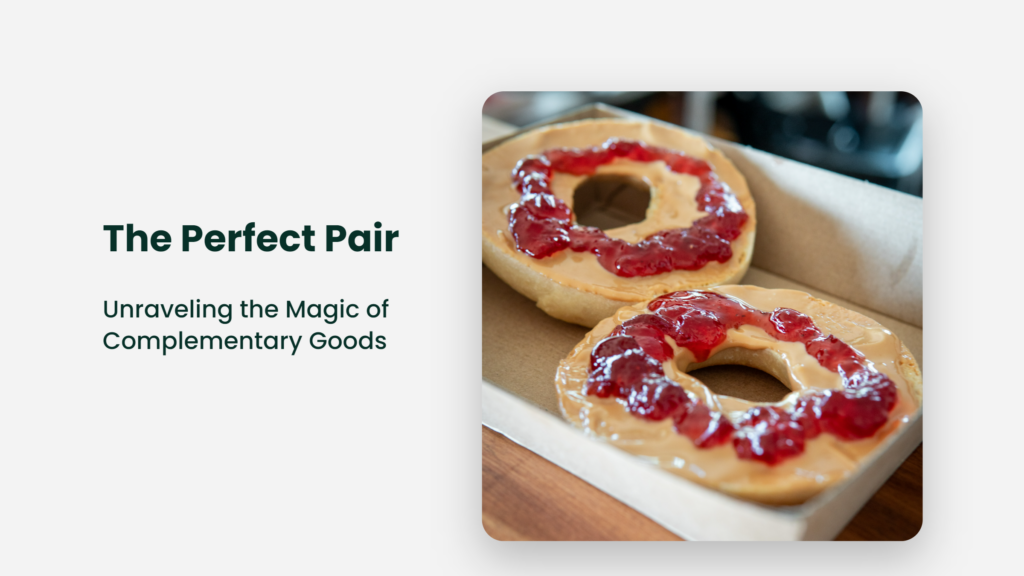

The Perfect Pair: Unraveling the Magic of Complementary Goods

As Seen On
Once upon a time, in the land of Economics, there was a fascinating phenomenon known as “complementary goods.” These peculiar goods had an extraordinary power: when they came together, they created a magical synergy that could drive demand and transform markets. This is their story.

Act One: The Enchanting Encounter
Picture a world where peanut butter met jelly for the first time. It was a chance encounter that would forever change the course of sandwiches. An unlikely duo, they had nothing in common – peanut butter was sticky and thick, while jelly was smooth and sweet. And yet, something magical happened when they were combined. It was like Fred Astaire and Ginger Rogers, two distinct individuals who danced together in perfect harmony.
As the wise man Aristotle once said, “The whole is greater than the sum of its parts.” In economics, peanut butter and jelly are classic examples of complementary goods. These are products that, when consumed together, increase the overall utility or value for the consumer. They are the yin to each other’s yang, the Batman to their Robin, the salt to their pepper.
In this enchanting tale of supply and demand, let’s explore the captivating dynamics of complementary and substitute goods and how they shape our world.
Act Two: The Irresistible Attraction

“Why do complementary goods hold such a spell over us?” you might wonder. Well, dear reader, there is a method to this madness.
The key to understanding the magnetism of goods lies in their ability to create value. When used together, complementary products can enhance the experience or functionality of each other. As a result, the cross elasticity of demand for one complementary good drives the need for the other.
For instance, consider the iPhone and the App Store. The iPhone, a groundbreaking invention on its own, becomes infinitely more valuable with access to the App Store’s endless collection of apps. Conversely, the App Store becomes a treasure trove of possibility only when accessed through the iPhone.
It’s a beautiful dance – a tango of supply and consumer demand, where one partner’s success relies on the other. But beware, this dance is not always smooth, and the steps can sometimes be complicated.
Act Three: The Art of Swaying the Market

“If a picture is worth a thousand words, then what is the value of a perfectly timed joke?” you ask, eager to test the potency of humour. Let’s see, shall we?
Did you hear about the economist who tried to explain complementary goods using cats and mice? He called it “The Furry Handcuffs Theory.” It turns out; even economists have a sense of humour.
In all seriousness, the relationship between complementary goods can significantly impact the market. Price, availability, and consumer preferences influence the delicate balance of supply and demand. For example, if the cost of peanut butter skyrockets, demand for jelly may dwindle as fewer people are willing to buy the expensive peanut butter.
To understand the impact of complementary goods on the market, let’s take a quick poll:
Which of the following complementary goods has the most significant influence on your purchasing decisions?
- Printer and ink cartridges
- Car and gasoline
- Smartphone and mobile data plan
In reality, it’s a trick question. These examples highlight complementary goods’ powerful sway on our decisions and the market.
Act Four: The Alluring Dance of Innovation

It’s been said that “necessity is the mother of invention.” Yet, when it comes to complementary goods, innovation can be both the parent and the offspring.
Take, for instance, the electric car and charging stations. As electric vehicles (EVs) became more popular, the joint demand for charging infrastructure grew. In response, companies like Tesla developed extensive charging networks to support their cars, further driving EV adoption. This symbiotic relationship spurred innovation in vehicle technology and charging infrastructure, creating a virtuous cycle.
The relentless pursuit of progress often leads to creating goods, as new technologies give rise to new opportunities and challenges. In the words of the great innovator Thomas Edison, “I have not failed. I’ve just found 10,000 ways that won’t work.”
Act Five: The Bewitching World of Policy
As we waltz through this enchanting tale of complementary goods, it’s worth noting that the dance floor is often influenced by the invisible hand of public policy. Governments play a crucial role in shaping the market for complementary goods through regulations, taxes, and incentives.
Consider, for example, the impact of the Renewable Fuel Standard (RFS) in the United States. The RFS mandates blending biofuels like ethanol into the gasoline supply. This policy has transformed the market for both gasoline and biofuels, driving demand for these complementary goods and influencing their prices.
As we can see, the mesmerizing dynamics of goods are shaped by the interplay of market forces, innovation, and public policy. It’s a complex dance, indeed, but one that reveals the intricate beauty of our economic world.
Epilogue: The Enchanted End
And so, dear reader, we have reached the end of our tale. As we bid farewell to the captivating world of complementary goods, let us remember the lessons we’ve learned:
- The synergistic magic that arises when two seemingly distinct goods come together.
- The delicate dance of supply and demand.
- The powerful forces that shape our market.
Before we part ways, here’s a little quiz to test your knowledge:
- What is the definition of complementary goods?
- How does the relationship between complementary goods impact the market? Can you give an example of a pair of complementary goods?
And now, a final rhetorical question for you to ponder: What new complementary goods might emerge as technology and innovation continue to shape our world?
Frequently Asked Questions
Q: What are complementary goods?
A: Complementary goods are products that, when consumed together, increase the overall utility or value for the consumer. Examples include peanut butter and jelly, printers and ink cartridges, and cars and gasoline.
Q: How do complementary goods impact the market?
A: The relationship between complementary goods can significantly influence the market, as the demand curve for one good drive the need for the other. Factors such as price, availability, and consumer preferences can also impact the market for complementary goods.
Q: How do complementary goods drive innovation?
A: Complementary goods can drive innovation by creating new opportunities and challenges that arise from the interplay between interests. For example, the development of electric vehicles led to the creation of charging infrastructure, further spurring innovation in vehicle technology and charging solutions.
Q: What role does public policy play in the market for complementary goods?
A: Public policy, including regulations, taxes, and incentives, can have a significant impact on the market for complementary goods. These policies can shape the product’s demand, price, and availability and drive innovation and the development of new complementary goods.
In a Nutshell
Now that we have danced the tango of supply and demand, it is time for you to go forth and explore the enchanting world of complementary goods. May the synergistic magic of these goods continue to captivate and inspire you, as they have done for so many before.
Konger
Up until working with Casey, we had only had poor to mediocre experiences outsourcing work to agencies. Casey & the team at CJ&CO are the exception to the rule.
Communication was beyond great, his understanding of our vision was phenomenal, and instead of needing babysitting like the other agencies we worked with, he was not only completely dependable but also gave us sound suggestions on how to get better results, at the risk of us not needing him for the initial job we requested (absolute gem).
This has truly been the first time we worked with someone outside of our business that quickly grasped our vision, and that I could completely forget about and would still deliver above expectations.
I honestly can't wait to work in many more projects together!
Disclaimer
*The information this blog provides is for general informational purposes only and is not intended as financial or professional advice. The information may not reflect current developments and may be changed or updated without notice. Any opinions expressed on this blog are the author’s own and do not necessarily reflect the views of the author’s employer or any other organization. You should not act or rely on any information contained in this blog without first seeking the advice of a professional. No representation or warranty, express or implied, is made as to the accuracy or completeness of the information contained in this blog. The author and affiliated parties assume no liability for any errors or omissions.

